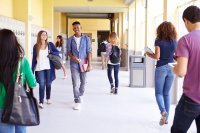Student-Led Culture Change
A look at some ways administrators can foster active participation by students in improving school culture.
Your content has been saved!
Go to My Saved Content.The tardy bell rang 15 minutes ago. You spot five students yelling and running into the restroom as you turn the corner, and you ask yourself, “What can I do to encourage these kids to report to their classrooms on time and ready to learn?”
School leaders spend much of their day focused on the management and logistics of running a school, but creating a positive and inclusive culture requires paying attention to different facets of the campus environment. Involving students in shaping the learning environment can yield positive results.
The protégé effect, or using peer-to-peer techniques, can be useful not only in the classroom but in developing a healthier, more positive school culture. School leaders should involve student leaders in the implementation of Positive Behavioral Interventions and Supports (PBIS) to consistently foster an environment that’s conducive to learning.
Schedule Time for Interaction
School leaders have many competing priorities, but scheduling time for face-to-face interaction with students is vital to creating a positive school culture. Because it is not possible to meet with every student, consider selecting a group of students who represent different facets of the school campus for monthly in-person interaction.
Teachers and other students can make useful recommendations about who might best represent the varied interests and skills of a student body. Creating a smaller student ambassador cohort and designating routine interactions gives administrators the opportunity to hear about campus concerns.
When I initiated regular meetings with students who were in the top 10 percent academically, I found that other students were reluctant to hold conversations with these ambassadors. We moved to a system that ensures more diversity from the student body because we recognized the importance of having students build authentic relationships with many of their peers.
Communicating directly with students also demonstrates a commitment to your shared vision for the culture and climate of the school. The meetings provide a space for students to share their peers’ cares, concerns, and celebrations.
Establish Objectives and Encourage Collaboration
During the meetings, discuss with students the PBIS objectives they can implement with peers. Specific objectives could include hallway behavior during class changes (e.g., walking on the right at all times to improve traffic flow, and wearing ID badges at all times).
In our meetings, we also identify priorities for school culture from the administration’s perspective. For example, we encourage students to consider ways to address cyberbullying. Once the goals are agreed upon, students can work to develop ways to communicate those goals to others. In our school, students make posters or handouts using acronyms that are easy to read and universally understood by students and staff as visual reminders of our shared objectives.
Peer-to-peer interaction is also valuable in establishing a positive school culture. Seniors in our school designed a mentoring program for underclassmen to decrease behavior referrals.Ten seniors recommended by teachers worked with a group of 20 students from the lower grades over a nine-week period. The principal and seniors spoke before each session and shared behavior strategies they intended to use, like self-regulation, self-monitoring, and self-advocacy.
The seniors had an opportunity to give younger students advice regarding how they should manage disruptive impulses that might lead to misbehavior in class. They also encouraged their younger peers to speak up in class when they did not understand a concept. The seniors took ownership over the development and success of the program.
Create Predictable Consequences
For effective PBIS, administrators need to provide predictable consequences for problem behaviors. The consequences are most effective when students are involved in their implementation through the creation of a social contract that details the expected behaviors and the consequences students will receive if they do not follow the code of conduct. In our school, the agreed consequences are: (a) a warning and assignment of a behavior essay, (b) a phone call home, and/or (c) an office referral.
When students do not adhere to the code of conduct, teachers and administrators ask the student and their peers to reflect upon the undesired behavior. Students categorize the behavior as a minor infraction or a major infraction using the social contract parameters they helped design.
Celebrate Successes
When administrators and staff give students ownership in their learning environments, it creates a sense of pride in students. In my school, we encourage students to use social media to tell our story. Students also follow our Instagram and Twitter feeds, where they can tag each other for positive behaviors. When a student receives a “spotlight” recognition from a teacher or peer, we post their picture in the commons area with a caption about what makes the student exceptional.
Finding ways to celebrate success fosters more active participation by students in shaping school culture inside and outside of the classroom.
